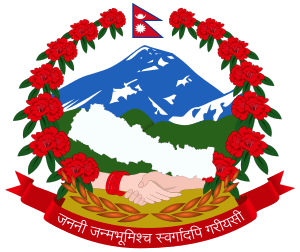Shah dynasty
| Shah Dynasty शाह वंश | |
|---|---|
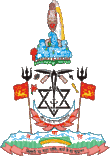 | |
| Country | |
| Ethnicity | Thakuri |
| Founded | 16th century |
| Founder | Kulamandan Khan (Shah) |
| Current head | Gyanendra Bir Bikram Shah |
| Final ruler | Gyanendra Bir Bikram Shah |
| Titles |
|
| Religion | Hinduism |
| Estate(s) | of Nepal |
| Deposition | 28 May 2008 (presently as pretender) |
Part of a series on the |
|---|
| History of Nepal |
 |
|
| Timeline |
|
|
Shah dynasty (Nepali: शाह वंश) was the ruling Thakuris from the Indian subcontinent of the Gorkha Kingdom from 1559 to 1768, the Kingdom of Nepal from 1768 to 28 May 2008.
Background
Scottish contemporary writer Francis Buchanan-Hamilton in his journal writes:
The family of Gorkha which now governs Nepal, although it pretends to come from Chitaur, according to Sadu Ram[note 1], a good authority, is, in reality, of the Magar tribe; and, at any rate, these people are now firmly attached to its interests, by having largely shared in the sweets of conquest; and by far the greatest part of the regular troops of that family is composed of this nation.
— An account of the Kingdom of Nepaul[2]
Coronation of Dravya Shah
Dravya Shah was the youngest son of Yasho Brahma Shah, Raja (King) of Lamjung and grandson of Kulamandan Khan, Raja (King) of Kaski.[3] He became the king of Gorkha with the help of accomplices. He ascended the throne of Gorkha on 1559 A.D. 19th century writer Daniel Wright describes the coronation of Drabya Shah as:
On Wednesday the 8th of Bhadon Badi, Saka 1481 (A.D. 1559) Rohini Nakshatra (i.e. the moon in the Rohini mansion) being an auspicious day, Drabya Sah aided by Bhagirath Panth, Ganesa Pande, Gangaram Rana, Busal Arjyal, Khanal Bohra and Murli Khawas of Gorkha, concealed himself in a hut. Ganesa Pande had collected all the people of who wore the brahmanical thread such as the Thapas, Busals, Ranas and Maski Ranas of the Magar tribe, they went by the Dahya Gauda route and the Durbar. Drabya Sah killed the Khadka Raja[note 2] his own hand, with a sword, during the battle ensued. At the same auspicious moment Drabya took his seat on the gaddi, amidst the clash music.
— History of Nepaul[3]
Previously, the local Ghale people had chosen their king from the winners of an annual running race. Dravya Shah was not a physically robust man but he tricked his way to the win. He was backed by the Bhattarai, Aryal, Adhikari, Pant and Acharya clans who were Brahmin. By 1570, when Dravya Shah died, the running race was but a memory among the people. Dravya Shah used the army of the Magar (an ancient tribe of Nepal) to invade neighboring states and his successors continued this aggression to increase the territory belonging to Gorkha. Kaji Ganesh Pande was his first minister of Gorkha.
Absolute monarchy (1768–1846)
In 1743, Prithvi Narayan Shah became the ruler of Gorkha. He declared war with other principalities, defeating them one by one. In September 1768, he established the unified kingdom of Gorkha. He became the first king of large Gorkha Kingdom. He, his sons and their successors continued fighting and defeating other kingdoms and enlarging the kingdom of Gorkha. In 1814, the Anglo–Gorkha War between Gorkha and the East India Company began. By 1815, the Shah king had been thoroughly defeated. By 1816, Gorkha had lost one third of its territory. The Shah kings continued to rule as absolute monarch until 1946 when the political order changed from absolute monarchy to a constitutional monarchy.
Hereditary prime ministers (1846–1951)

In 1846, the Rana dynasty gained power in Nepal. The Ranas became prime ministers and reduced the King's status to a figurehead position. The Ranas ruled Nepal as hereditary prime ministers though in the name of the figurehead king. In 1950, the Shah king King Tribhuvan was forced into exile in India. He and his family, including the crown prince Mahendra, were saved. After India became a secular state in 1950, and the remaining rajas retired, Nepal was the only remaining Hindu kingdom. In 1951, with the help of India, a popular politician common man Matrika Prasad Koirala became the prime minister of Nepal. Tribhuvan returned to Kathmandu. The Shah dynasty regained control and the prime minister, Mohan Shamsher Jang Bahadur Rana, resigned. King Tribhuvan ruled until 1955 and King Mahendra ruled until 1972. Mahendra's son, Birendra, became king.
Constitutional monarchy (1990–2008)
In 1990, under King Birendra, Nepal became a constitutional monarchy. King Birendra believed in cooperation between the absolute power of the monarchy and democratic governance. His brother, Gyanendra and his wife Queen Aishwarya staunchly opposed this.
Murder of the royal family
On 1 June 2001, a number of members of the Shah dynasty were murdered in the royal palace. A High Commission report concluded that the royal family was slaughtered by Crown Prince Dipendra. This remains controversial. Among the dead were the Crown Prince's father, King Birendra and his brother, Prince Nirajan. After the attack, Dipendra was in a coma and was declared king for a short time. He died a few days later. Gyanendra Bir Bikram Shah Dev, Dipendra's uncle, took the throne. In February 2005, he dismissed the parliament in order to govern in his own right.
Abolition of the Shah monarchy
On 24 December 2007, the Nepalese Constituent Assembly met. It was decided by majority vote that the monarchy would be abolished in 2008 after the Constituent Assembly elections.[4] On 28 May 2008, the Assembly declared Nepal a Federal Democratic Republic and the monarchy was abolished, removing the Shah dynasty from power. Kul Bahadur Gurung said of the 601 member assembly, 560 voted in favour, 4 were against and 37 were absent or abstained. After this Assembly agreement involving the Nepali Congress, the Communist Party of Nepal (Unified Marxist–Leninist) and the Communist Party of Nepal (Maoist), Gyanendra stepped down.
Gyanendra vacated his palace in Kathmandu which later became a museum. Until they could find permanent accommodation, the royal couple were offered residence as commoners at the Nagarjuna Palace, a former royal summer residence. The Nagarjuna palace lies in forested hills about eight kilometres (five miles) northwest of Kathmandu.
Hamilton Buchanan wrote a book An account of Kingdom of Nepal and says The family of Gorkha which now governs Nepal, although it pretends to come from Chitaur, according to Sadu Ram, a good authority, is, in reality, of the Magar tribe.
Monarchs of Shah dynasty (1559–2008)
Monarchs of Shah dynasty of Gorkha (1559-1768)
The following is list of all ten kings of Gorkha hill principality [5][6][7]
| Name | Lifespan | Reign start | Reign end | Notes | Family | Image |
|---|---|---|---|---|---|---|
Dravya Shah
| died 1570 | 1559 | 1570 | Son of Yasho Brahma Shah | Shah | |
Purna Shah/Purendra Shah
| died 1605 | 1570 | 1605 | Son of Dravya Shah | Shah | |
Chatra Shah
| died 1609 (heirless) | 1605 | 1609 | First son of Purendra/Purna Shah | Shah | |
Ram Shah
| died 1636 | 1609 | 1633 (abdicated) | Second son of Purna/Purendra Shah adopted title of Svasti Sri Giriraj | Shah | |
Dambar Shah
| died 1645 | 1633 | 1645 | Son of Ram Shah | Shah | |
Krishna Shah
| died 1661 | 1645 | 1661 | Son of Dambar Shah | Shah | |
Rudra Shah
| died 1673 | 1661 | 1673 | Son of Krishna Shah | Shah | |
Prithvipati Shah
| died 1716 | 1673 | 1716 | Son of Rudra Shah | Shah | |
Nara Bhupal Shah
| 1697- 3 April 1743 | 1716 | 1743 | Grandson of Prithvipati Shah and Son of Prince Birbhadra Shah | Shah | |
Prithvi Narayan Shah
| 7 January 1723[8] – 11 January 1775 (aged 52) | 1743 | 25 September 1768 | Son of Nara Bhupal Shah | Shah | 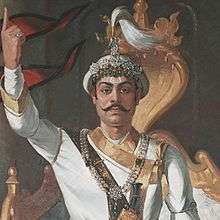 |
Monarchs of Shah dynasty of Nepal (1768–2008)
| Name | Lifespan | Reign start | Reign end | Notes | Family | Image |
|---|---|---|---|---|---|---|
Prithvi Narayan Shah
| 7 January 1723[9] – 11 January 1775 (aged 52) | 25 September 1768 | 11 January 1775 | Son of Nara Bhupal Shah | Shah | 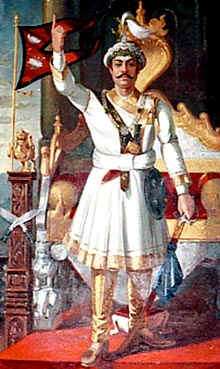 |
Pratap Singh Shah
| 16 April 1751 – 17 November 1777 (aged 26) | 11 January 1775 | 17 November 1777 | Son of Prithvi Narayan Shah | Shah | 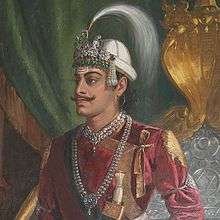 |
Rana Bahadur Shah
| 25 May 1775 – 25 April 1806 (aged 30) | 17 November 1777 | 8 March 1799 (abdicated) | Son of Pratap Singh Shah | Shah | 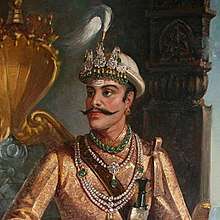 |
Girvan Yuddha Bikram Shah
| 19 October 1797 – 20 November 1816 (aged 19) | 8 March 1799 | 20 November 1816 | Son of Rana Bahadur Shah | Shah | 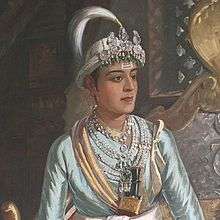 |
Rajendra Bikram Shah
| 3 December 1813 – 10 July 1881 (aged 67) | 20 November 1816 | 12 May 1847 (abdicated) | Son of Girvan Yuddha Bikram Shah | Shah | 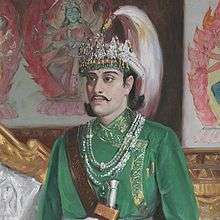 |
Surendra Bikram Shah
| 20 October 1829 – 17 May 1881 (aged 51) | 12 May 1847 | 17 May 1881 | Son of Rajendra Bikram Shah | Shah | 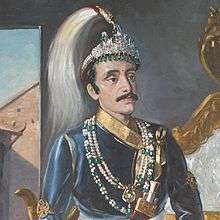 |
Prithvi Bir Bikram Shah
| 18 August 1875 – 11 December 1911 (aged 36) | 17 May 1881 | 11 December 1911 | Grandson of Surendra Bikram Shah | Shah | 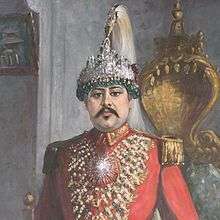 |
| Tribhuvan Bir Bikram Shah (1st reign)
| 30 June 1900 – 13 March 1955 (aged 54) | 11 December 1911 | 7 November 1950 (went into exile) | Son of Prithvi Bir Bikram Shah | Shah | 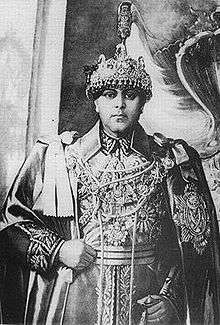 |
| Gyanendra Bir Bikram Shah (1st reign)
| 7 July 1946 | 7 November 1950 | 7 January 1951 (stepped down) | Grandson of Tribhuvan Bir Bikram Shah | Shah | 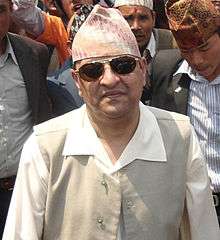 |
| Tribhuvan Bir Bikram Shah (2nd reign)
| 30 June 1900 – 13 March 1955 (aged 54) | 7 January 1951 | 13 March 1955 | Son of Prithvi Bir Bikram Shah | Shah |  |
Mahendra Bir Bikram Shah
| 11 June 1920 – 31 January 1972 (aged 51) | 14 March 1955 | 31 January 1972 | Son of Tribhuvan Bir Bikram Shah | Shah | 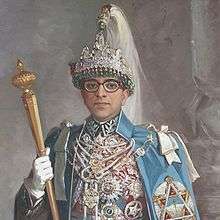 |
Birendra Bir Bikram Shah
| 28 December 1944 – 1 June 2001 (aged 56) | 31 January 1972 | 1 June 2001 (assassinated) | Son of Mahendra Bir Bikram Shah | Shah | 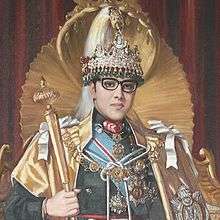 |
Dipendra Bir Bikram Shah
| 27 June 1971 – 4 June 2001 (aged 29) | 1 June 2001 | 4 June 2001 (suspected murder) | Son of Birendra Bir Bikram Shah | Shah | |
| Gyanendra Bir Bikram Shah (2nd reign)
| 7 July 1946 | 4 June 2001 | 28 May 2008 (deposed; presently as pretender) | Son of Mahendra Bir Bikram Shah | Shah |  |
Maternal roots of Shah dynasty
Family tree of the all Shah kings of Nepal (not of previous Gorkha Kingdom) except Gyanendra Bir Bikram Shah, brother of King Birendra Bir Bikram Shah:
See also
References
Footnotes
Notes
- ↑ Hamilton 1819, p. 4.
- ↑ Hamilton 1819, p. 26.
- 1 2 3 Wright 1877, p. 278.
- ↑ "Nepalese monarchy to be abolished." BBC 24 December 2007 Accessed 25 December 2007.
- ↑ http://www.royalark.net/Nepal/nepal2.htm
- ↑ http://www.royalark.net/Nepal/nepal3.htm
- ↑ http://www.royalark.net/Nepal/nepal4.htm
- ↑ Accordingly Royal Ark, he was born on 25 December 1722
- ↑ Accordingly Royal Ark, he was born on 25 December 1722
- ↑ Chaudhari, K.C (1960). Anglo-Nepalese Relation. Calcutta: Modern Book Agency Private Ltd.
- ↑ राणा, प्रमोदशमशेर (2009). राणाशासनको वृत्तान्त. Kathmandu: Pairavi Book House. p. 3. ISBN 978-11146-30-72-7.
Books
- Wright, Daniel (1877), History of Nepal, Cambridge University Press
- Hamilton, Francis Buchanan (1819), An Account of the Kingdom of Nepal, and the Territories Annexed to this Dominion by the House of Gorkha, A Constable
External links
- Royal Court of Nepal Nepalese government website.
- The Royal House of Nepal Royal Ark website.
- Gregson J. "Massacre at the palace; the doomed royal dynasty of Nepal." 2002.
